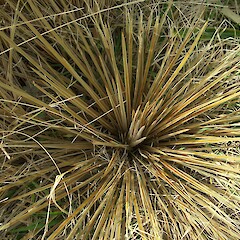Aciphylla subflabellata
Common name
speargrass
Synonyms
None
Family
Apiaceae
Flora category
Vascular – Native
Endemic taxon
Yes
Endemic genus
No
Endemic family
No
Structural class
Herbs - Dicotyledons other than Composites
NVS code
The National Vegetation Survey (NVS) Databank is a physical archive and electronic databank containing records of over 94,000 vegetation survey plots - including data from over 19,000 permanent plots. NVS maintains a standard set of species code abbreviations that correspond to standard scientific plant names from the Ngä Tipu o Aotearoa - New Zealand Plants database.
ACISUB
Current conservation status
The conservation status of all known New Zealand vascular plant taxa at the rank of species and below were reassessed in 2017 using the New Zealand Threat Classification System (NZTCS) – more information about this can be found on the NZTCS website. This report includes a statistical summary and brief notes on changes since 2012 and replaces all previous NZTCS lists for vascular plants.
Please note, threat classifications are often suggested by authors when publications fall between NZTCS assessment periods – an interim threat classification status has not been assessed by the NZTCS panel.
- Conservation status of New Zealand indigenous vascular plants, 2017 . 2018. Peter J. de Lange, Jeremy R. Rolfe, John W. Barkla, Shannel P. Courtney, Paul D. Champion, Leon R. Perrie, Sarah M. Beadel, Kerry A. Ford, Ilse Breitwieser, Ines Schönberger, Rowan Hindmarsh-Walls, Peter B. Heenan and Kate Ladley. Department of Conservation. Source: NZTCS and licensed by DOC for reuse under the Creative Commons Attribution 4.0 International licence.
2017 | At Risk – Declining | Qualifiers: DP, Sp
Previous conservation statuses
2012 | At Risk – Declining | Qualifiers: DP, Sp
2009 | At Risk – Declining | Qualifiers: DP, Sp
2004 | Sparse
Distribution
Endemic. South Island in the east from south-eastern Marlborough to Southland
Habitat
Montane to subalpine (300-1400 m a.s.l.). Usually in dry sites on alluvial terraces, gentle rolling slopes and colluvium, intermontane basins amongst short or tall tussocks and on the margins of grey scrub. Sometimes on or near rock outcrops or amongst boulders.
Wetland plant indicator status rating
Information derived from the revised national wetland plant list prepared to assist councils in delineating and monitoring wetlands (Clarkson et al., 2021 Manaaki Whenua – Landcare Research Contract Report LC3975 for Hawke’s Bay Regional Council). The national plant list categorises plants by the extent to which they are found in wetlands and not ‘drylands’. The indicator status ratings are OBL (obligate wetland), FACW (facultative wetland), FAC (facultative), FACU (facultative upland), and UPL (obligate upland). If you have suggestions for the Wetland Indicator Status Rating, please contact: [Enable JavaScript to view protected content]
UPL: Obligate Upland
Rarely is a hydrophyte, almost always in uplands (non-wetlands).
Detailed description
Stout perennial forming stout rosettes. Stems up to 0.8 m long. Leaves yellow-green to grey-green, narrowly subflabellate-bipinnate. Sheaths membranous, up to 20 mm long, ligules 2, up to 10 mm long; stipules 20 mm long, irregularly bipinnate. Petioles 25 x 5 mm, concavo-convex with internodes up to 25 mm long. Primary pinnae 3-4 pairs, these strongly serrulate-crenulate on midrib and margins, sometimes pinnate again with leaflets up to 200 x 3 mm, narrowly acicular. Stems stout, deeply grooved up to 1 m x 25 mm, including inflorescence 0.5-0.6 m long. Bracts numerous, close-set; sheaths up to 70 x 10 mm; stipules erect, simple to bifid, up to 150 x 1 mm; central leaflet up to 300 mm long, at length strongly reflexed, margins serrulate. Umbels exceeding the bract-sheaths especially in the male inflorescence. Mericarps 5-12 mm long with 5 ribs, 3-4 of these winged.
Similar taxa
Perhaps most similar to A. squarrosa., and in someways resembling a more finely divided varaint of it. A. subflabellata is a much smaller plant than the typical form of A. squarrosa, and differs by the subflabellate flattened leaves - a condition caused by the close-set leaf pinnae which are positioned more or less in the same plane as the leaf axis
Flowering
December - February
Flower colours
Yellow
Fruiting
February - May
Life cycle
Winged schizocarps are dispersed primarily by wind (Thorsen et al., 2009).
Propagation technique
One of the easier species to cultivate, though it dislikes humidity and excessive moisture. Should be planted in a sunny, free draining situation. Once planted do not transplant or disturb roots. Can be grown in a tub.
Threats
Widespread but generally never common. Possibly it is more threatened than believed because many of its lowland habitats are extremely modified, weed infested and plants are browsed where accessible by cattle, rabbits and hares. Current herbarium evidence suggests that this species is still poorly known but that from available evidence it is naturally uncommon over large parts of its stated range.
Etymology
aciphylla: From the Latin acicula ‘needle’ and the Greek phyllum ‘leaf’, meaning needle-leaf.
subflabellata: Somewhat fan-like
Attribution
Fact sheet prepared for NZPCN by P.J. de Lange (1 September 2004). Description based on Allan 91961).
References and further reading
Allan, H.H. 1961: Flora of New Zealand. Vol. I. Government Priniter, Wellington.
Thorsen, M. J.; Dickinson, K. J. M.; Seddon, P. J. 2009. Seed dispersal systems in the New Zealand flora. Perspectives in Plant Ecology, Evolution and Systematics 11: 285-309
NZPCN Fact Sheet citation
Please cite as: de Lange, P.J. (Year at time of access): Aciphylla subflabellata Fact Sheet (content continuously updated). New Zealand Plant Conservation Network. https://www.nzpcn.org.nz/flora/species/aciphylla-subflabellata/ (Date website was queried)











